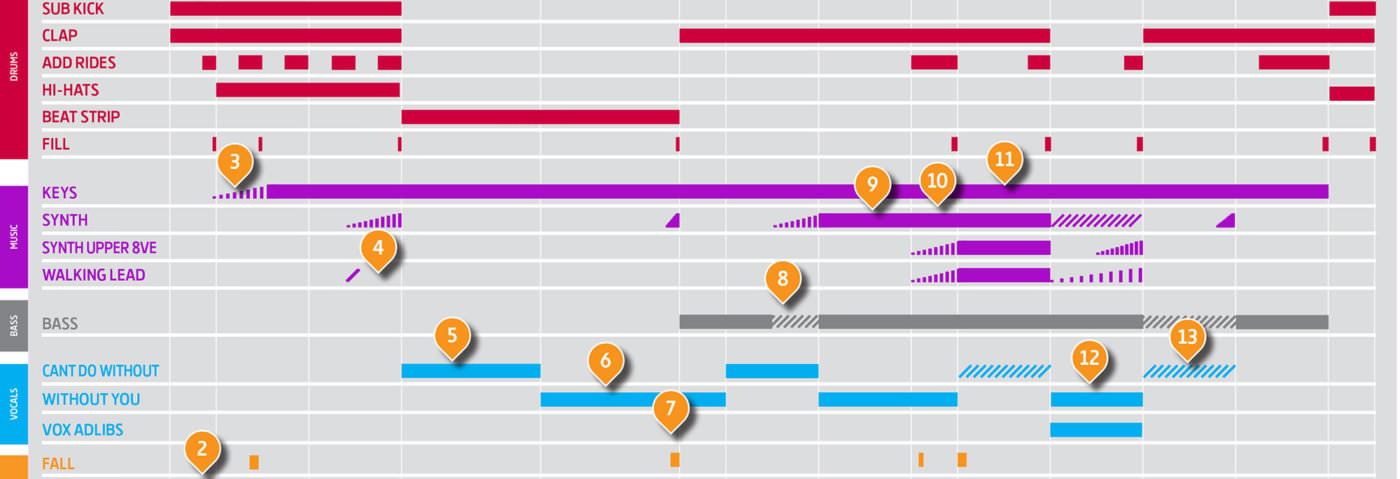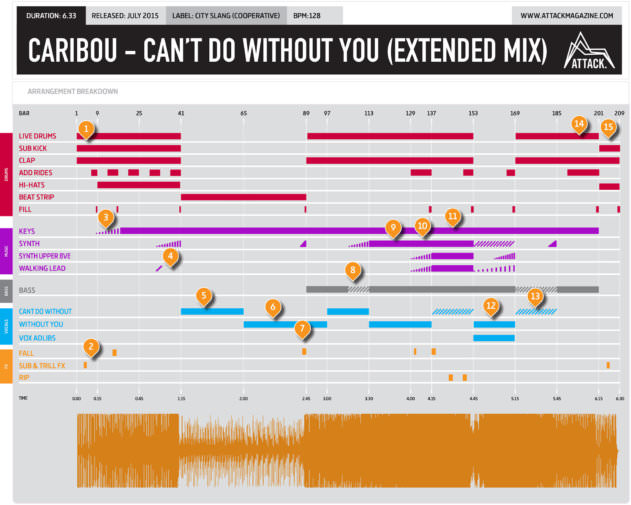By popular demand, we deconstruct the arrangements of tracks to see what we can learn from their structure.
This month we deconstruct Caribou’s summer 2014 anthem ‘Can’t Do Without You’ and find an arrangement in constant flux that breaks with more than a few dance mixing standards.
The track
The arrangement
What’s happening?
1. The track opens with a mixture of live drums, a programmed kick that underpins the groove and a spritely layered clap. The signal from the clap is fed to a spring reverb at various points to give the eight-bar section nuance. An ‘added ride’ layer featuring a mix of ride and bell ride enters in the final two bars, pre-empting a short live drum fill. The use of live drums throughout the track sets ‘Can’t Do Without You’ apart from the programmed beats in the vast majority of dance mixes. Although there are sections of repeat loops, the beat changes throughout the track, with regular live drum fills giving an organic, ever-changing backdrop to the track. You can get a feel for both the drumming talent and the changing grooves in the two live videos here and here. Note how one drummer plays the main beats, with the second supplying fills and ride/bell ride overlays.
The use of live drums throughout the track sets 'Can't Do Without You' apart from the programmed beats in the vast majority of dance mixes
2. The track uses very few FX. A sub drone in the fourth bar and a short synth ‘fall’ in bar 16 supply brief bursts of ear candy.
3. In comes the simple chordal keys that supply the melodic backbone throughout the entire track. What’s the instrument? It sounds a bit like a combination of Rhodes and clav. The part’s volume is gently increased and the filter cutoff frequency is raised into bar 17. A tape-style delay with an ever-shifting delay time gives the part a rich character and contributes to the rhythmic movement of the whole track. A new programmed drum element is added in the form of a busy hi-hat part that toys with the groove, playing triplets at times and 16ths at others. If it’s not yet obvious, this is not the kind of brutally simple arrangement exhibited by Tiga in our first deconstruction – it’s one that’s in a constant state of flux, with multiple rhythmic, instrumental and timbral changes occurring at any given time.
4. A ‘walking’ synth part playing a simple ascending pattern enters briefly for the first time in bar 31, with the filter pulled back to limit its impact. The part won’t reappear until the drop at bar 129, making this an early exposition of a theme that will be picked up later. Planting the motif in the listener’s mind at this early stage is a nifty arrangement trick, adding continuity across the six-and-a-half minute running time of the extended mix. The walking lead bleeds into the first appearance of a saw-wave synth part. As with the entry of the keys, its volume and cutoff frequencies are both increased (before being lowered) into the turnaround at bar 41. Note that the melody played by the synth is almost identical to that which will be picked up on the bass in another 40 or so bars – an interesting sharing of melodies between different instrumental parts.
The part won't reappear until the drop at bar 129, making this an early exposition of a theme that will be reinforced later
5. The track breaks down and in come the simple but very effective vocals. The track features three vocal loops in all; the first “can’t do without” loop, sampled from an acapella of Marvin Gaye’s ‘Ain’t That Peculiar’. The other parts – the falsetto “I can’t do without you” and ad-libbed phrases in the second breakdown – are both sung by Dan Snaith himself. The beat is stripped back to a simple disco-style kick/snare/clap loop with a hi-hat that has been bracketed to take out both the high and low end.
6. In comes the second vocal part. The interplay between this and its forebear are crucial to the song’s arrangement, with neither ever playing together. Note the song’s adoption of various turnaround lengths. While 8 and 16 bars are the norm in the wider arrangement, in these initial vocal introductions, turnarounds occur after an atypical 24 bars.
7. A drum fill, FX fall and synth crescendo lead into the first straight exposition of all key elements – drums, bass, keys and vocals. But it’s the filter bypasses that make the transition so pronounced. The filters (dialled low on the stripped beat, vocals and keys for the drop) are bypassed, opening up the mix and instantly upping the song’s energy. A couple of other things to note: firstly, the relatively straight groove of the live drums – played for the first time without the programmed kick underlay; secondly, the lack of an obvious kick drum, with the buzzy bassline doing most of the low-end heavy lifting.
8. We’re back to the the opening vocal loop. Automation of the bassline’s distortion keeps things interesting, while the keys are shifted slightly off-grid for a lazier feel. A double keys hit at bar 105 keeps the listener engaged. At the end of the 16 bar section the synth swells into the mix.
9. The vocal loop changes again, this time underpinned by the chordal synth part. Movement is everywhere, with volume, cutoff frequency and resonance all being continually tweaked, the filter opening as the pressure builds towards the track’s main drop.
10. This eight-bar section is all about building the energy, with added rides upping rhythmic interest, the walking lead re-entering the mix – cutoff frequency and volume edging upwards – as a fill, embellished with a full-mix flange edit, propels us into the drop.
11. Energy converges across the whole mix for the euphoric drop. With the previous four-and-a-half minutes building towards it, the payback has to deliver. And it does, with movement everywhere in the mix. The live drums pick up the energy, a busy hi-hat shuffle upping the urgency, while all synth parts are increased in volume, filters widening still. This is also the most FX-dense section of the song, opening with a fall and closing with two automated buzz ‘rips’. To make space in the mix for the ever-building synths, the vocal volume is lowered, with some of the words lost in the mix. A key production point to note here is how low the drums are mixed. Veering away from the usual dance production maxim that asks for drums to take centre stage, it’s the synths that dominate here, offering a useful insight into how low drums can be pushed in a mix that still bristles with energy.
With the previous four-and-a-half minutes building towards it, the payback has to deliver. And it does
12. The drums leave the mix for a second breakdown. Before the song heads to the finish line, Snaith has a few final tricks up his sleeve to keep things fresh – the introduction of a new part and one last build. The new part is an ad-libbed vocal that riffs off the familiar main vox loop. Elsewhere, the now-established tricks to build energy are given one last flourish, with filters opening and volumes rising across all synth parts. The upper synth adopts a new sequence this time, playing subtle stabby 8ths to plant a driving pattern behind the re-emerging drums and rides. A second full-mix flange wash, albeit with less energy than the previous instance, carries the track into the turnaround.
13. It’s wind-down time, with the steady beat back in the mix and interest maintained by some judicious automation of the bassline’s tonality and distortion. A nice touch is the use of occasional reverb spins on the vocal loop.
14. The live drums return to the more insistent groove laid down in the drop, this time underpinned by the resurrected programmed kick. Scattered added rides and widely panned crashes keep the high-end busy.
15. The outro loses the live drums altogether for a satisfying programmed beat finale, with the hi-hat pattern increasing in volume and complexity, slapback delays delivering a two-measure shadow, as the same reverb splashes heard in the intro are applied to the clap. A neat fill rounds off the track.


02.41 PM
Great breakdown of a great track. Thanks guys.
11.31 AM
Great post 🙂 I learn everytime a lot from these breakdows!
10.40 PM
always some good stuffz thx fam
07.00 PM
There is no sound in that link
08.24 PM
thanks a lot!! this is very interesting. could you upload the session for Ableton Live too??